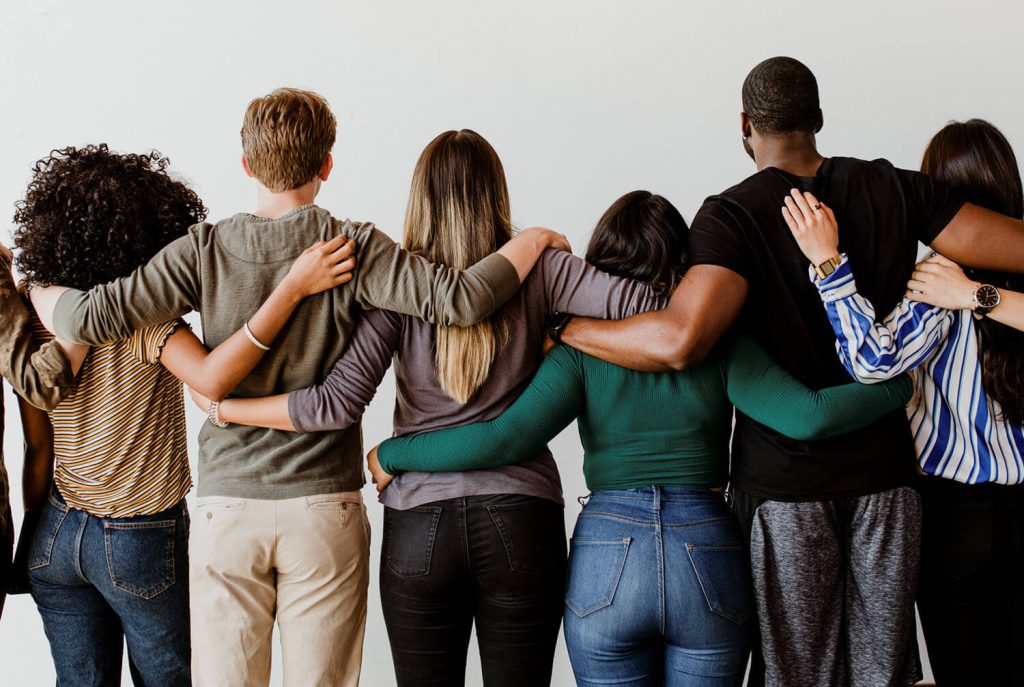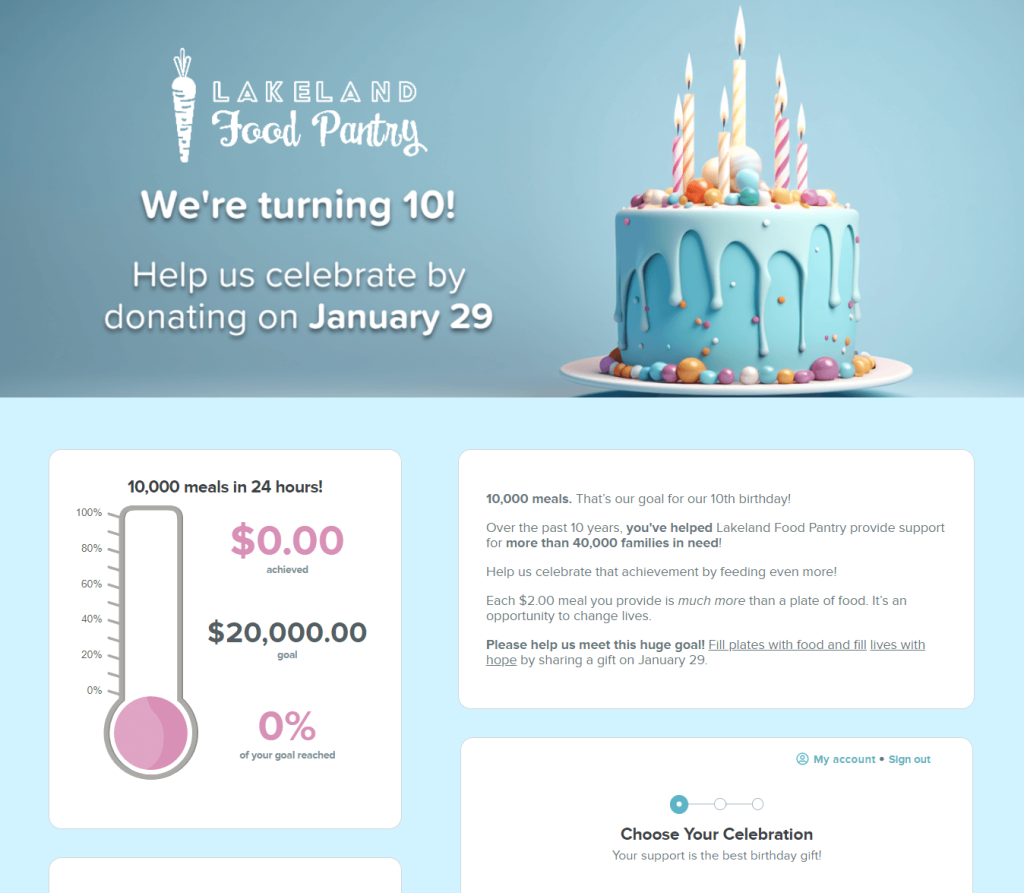Most people are familiar with Giving Tuesday—a single 24-hour day of giving on the Tuesday after American Thanksgiving. But Giving Tuesday doesn’t have to be the only nonprofit giving day on your organization’s fundraising calendar.
With the right fundraising software to design effective donation pages and a solid marketing plan, you can host a special giving day for your organization that’ll inspire your supporters to give.
In this article, we’ll explain why you should consider hosting your own giving day and share tips for setting up and marketing your campaign.
Why should you host a nonprofit giving day?
Hosting your own giving day apart from Giving Tuesday can have a lot of benefits for your organization.
First, Giving Tuesday has become so popular that the philanthropic “market” can get a little saturated. Donors only have so much capacity. If every organization is asking for gifts on the same day, it’s easy for donors to get overwhelmed. Scheduling a giving day during a different time of year can help you tap into the generosity of donors who aren’t already inundated with fundraising appeals.
Scheduling your own giving day also gives you a chance to pick a date that’s special to your organization. Giving Tuesday builds on the generous spirit of year-end giving, but it’s not specific to you. Picking your own date offers a lot of opportunity to customize your donation forms and tailor your messaging to something more meaningful.
These benefits are great, but hosting your own giving day means you won’t be able to take advantage of Giving Tuesday’s already established marketing and donor awareness. However, with the right marketing strategy, your nonprofit giving day can be a great fundraising opportunity for your organization!
Nonprofit giving day essential steps
1. Define your goals and objectives
As with any fundraising campaign, it’s important to set goals and objectives before you begin so you know where you’re trying to go!
If you’ve never hosted a nonprofit giving day before, it might be difficult to realistically predict how much you can raise in 24 hours. Here are a few strategies that can help:
- Reflect on past performance: Use data from previous fundraising campaigns, such as Giving Tuesday, to establish benchmarks and inform your goals for the giving day. Analyze your organization’s past fundraising efforts to understand what worked well and areas for improvement.
- Research local campaigns: Look at the performance of other nonprofits in your area during Giving Tuesday or similar fundraising events. Your research can provide insights into fundraising trends and help you set realistic goals based on local fundraising norms and competition.
- Consider matching donors: Partnerships and matching donors can have a major impact on a giving day. Once you’ve secured matching donors, factor their contributions into your goal-setting process.
- Set mini goals: Break down your overall fundraising goal into smaller, more achievable milestones to keep donors engaged throughout the giving day. Display these mini goals visually, such as with a fundraising thermometer, to inspire donors and track progress in real time.
Setting clear and achievable goals for your nonprofit giving day ensures you have a roadmap to guide your efforts and maximize your impact.
2. Choose a date
Pick a date important to your organization—like an anniversary or special event. Or pick a date that corresponds to a theme you’d like to lean into—like Valentine’s Day!
The key here is to ensure that your donation form theme and impact messaging are cohesive and mean something to you and your supporters.
3. Build partnerships / Recruit matching donors
We mentioned earlier that partners and matching donors can be huge for a giving day. When you only have 24 hours to fundraise, you need to maximize the gifts you’ll receive.
Securing a matching donor can boost your overall fundraising while inspiring other donors to give more. Be sure to include messaging that reminds donors that their gift could be worth double, and don’t forget to spotlight and thank your matching donors on your donation form!
This can also be a great opportunity to set up a mini goal! For example, challenge donors to give a certain amount before noon to secure an additional matching gift.
4. Design your donation form
Even if you have a year-round donation form that you love, it’s a good idea to create a separate donation form for your giving day. There are a few reasons why.
First, it’s easier to set and track goals for your giving day if the gifts you receive that day aren’t lumped together with your general donation form.
Second, one of the best things about hosting a giving day is getting to lean into a unique theme or a more focused part of your mission. Creating a new donation form means you can customize it to match that theme or focus. For example, if you’re hosting a Valentine’s giving day, you might want to emphasize heart imagery with lots of red and pink. Depending on your organization’s overall branding, that may not be appropriate for your everyday donation form, but it would be perfect for a single-day campaign!
Third, you need to promote your giving day. (We’ll talk about that more soon!) Promotion is a lot easier when you can send a direct link to the place you want donors to give.
Here are some things to keep in mind when designing your form:
- Create custom images: Because your giving day form is separate from your year-round form, it’s a great opportunity to create new banners and background images.
- Lean into the theme: Make your giving day form unique by incorporating the theme wherever you can. Think about your donation amount descriptions and images, update the language on your donation button, and change the colors of the form to match your custom images if your donation form platform allows you to make those customizations.
- Add impact statements: Make sure to include impact statements to remind donors why they should give to this particular campaign. It’s good to remind donors of your organization’s overall mission. If you can tailor the impact statements to the giving day’s specific goals, even better!
- Highlight your sponsors: If you’ve secured sponsors or matching donors for the day, don’t forget to recognize them. Include thank-you messaging on the donation form to recognize their support and to remind donors about the matches.
- Add thermometers: Thermometers are a great way to show impact throughout the day. Consider including both an overall thermometer and thermometers for your mini goals.
5. Develop marketing materials
As we mentioned before, the challenge of hosting your own giving day is that donors won’t be aware of it until you tell them! So you need to develop some marketing materials to make sure your supporters know about your campaign and when to give. Here are some ways to promote your day on channels you’re already using:
- Website: Your organization’s website serves as the central hub for your giving day campaign. Ensure that it prominently features information about the event, including its purpose, goals, and how supporters can participate. Create dedicated landing pages or banners to capture attention and direct visitors to donation forms or additional resources.
- Social media: The immediacy of social media can help you reach a broader audience for your giving day. Use countdown posts to build anticipation, encourage followers to share your posts, and use relevant hashtags to maximize visibility.
- Email: Utilize email marketing to communicate directly with your donor base and keep them informed about your giving day. Craft personalized messages that highlight the importance of their support, outline the impact of their contributions, and provide clear instructions on how to participate. Segment your email list based on donor preferences or giving history to tailor your messages for maximum relevance.
- Videos: Videos require more time and resources, but they’re a great way to capture attention and evoke emotion. Create compelling videos that showcase your organization’s mission and highlight the beneficiaries of your work. Videos can also convey the urgency of supporting your cause during the giving day. Share these videos across your website, social media channels, and email campaigns to captivate audiences and inspire action.
- Impact statements: As mentioned earlier, you want to craft impact statements specifically for your giving day. Highlight success stories and concrete examples of how funds raised during the giving day will be used to further your organization’s mission.
By leveraging diverse marketing materials, you can effectively raise awareness, drive engagement, and inspire generosity during your nonprofit giving day.
6. Launch pre-event promotion
At least a month before your giving day, start spreading the word. Remind donors that the day is coming and build hype. Building anticipation is key to the success of your nonprofit giving day. Here’s how to effectively promote your event in the weeks leading up to it:
- Start early: Begin spreading the word at least a month before your giving day. Remind your donors and supporters about the upcoming event to generate excitement and momentum.
- Send a save-the-date: Give your audience a heads-up by sending out save-the-date notifications well in advance. This ensures that your supporters have ample time to mark their calendars and prepare to participate in your giving day.
- Highlight sponsors and matching donors: Recognize and showcase the generosity of your sponsors and matching donors. Highlighting their contributions not only expresses gratitude but also encourages others to get involved to maximize their impact.
- Share impact stories: Fuel excitement by sharing stories that demonstrate the real impact of your organization’s work. By showcasing the difference their contributions make, you’ll inspire donors to participate enthusiastically in your upcoming giving day.
7. Host the giving day
When your nonprofit giving day arrives, it’s crucial to maintain momentum and keep donors engaged. Here’s how to make the most of the day:
- Stay active and engaged: Keep donors informed and involved throughout the day by providing regular updates on your progress. Use social media posts, email blasts, text message updates, and website announcements to share donation milestones, thank contributors, and showcase the impact of their support.
- Encourage participation: Keep the excitement going by encouraging donors to continue giving throughout the day. Use urgency-driven messaging to inspire last-minute donations and remind supporters of the impact their contributions can make before the day ends.
- Celebrate milestones: Celebrate key milestones and achievements you reach throughout the day, such as reaching fundraising goals or unlocking matching donation challenges. Recognize and thank donors for their contributions, and highlight the collective impact of their generosity on your organization’s mission.
- Show gratitude: Express gratitude to donors continuously throughout the giving day. Personalize thank-you messages and acknowledge individual contributions to make donors feel valued and appreciated for their support.
Create a dynamic and engaging giving day experience that encourages continued participation and maximizes support for your organization’s cause.
8. Show appreciation and follow up
As your nonprofit giving day comes to a close, it’s essential to express gratitude to your supporters and provide them with updates on the impact of their contributions. Here’s how to show appreciation and follow up effectively:
- Remember to show impact: After the flurry of activity on your giving day, take a moment to reflect on the collective impact achieved through the generosity of your donors. Use data and anecdotes to quantify and illustrate the tangible difference their contributions have made in advancing your organization’s mission.
- Update your donation page with a thank you and “How We Did”: Ensure that your donation page reflects the gratitude and appreciation you have for your donors. Update the page with a heartfelt thank-you message. Additionally, provide an overview of how the giving day performed, including key statistics such as total funds raised, number of donors reached, and any milestones achieved.
- Send a thermometer in emails with impacts: Follow up with donors via email to provide them with a comprehensive overview of the impact of their contributions. Include a visual representation of your fundraising progress, such as a thermometer graphic, to illustrate the collective impact of their donations.
- Thank matching donors again (and publicly): Take the opportunity to thank your matching donors once again for their generosity and commitment to your cause. Acknowledge their support publicly on your website, social media platforms, and other communication channels, highlighting their role in amplifying the impact of your giving day and inspiring others to contribute.
Showing appreciation and following up thoughtfully helps you foster a deeper connection with your donors. It also demonstrates transparency and accountability in how their contributions are being utilized to drive positive change.
9. Evaluate and learn
As your nonprofit giving day concludes, it’s essential to reflect on the experience and identify areas for improvement. Here are some key tips for evaluating and learning from your giving day:
- Review performance metrics: Analyze key performance indicators such as total funds raised, donor participation rates, and engagement levels across various channels. Identify trends and patterns to understand what worked well and areas for improvement.
- Gather feedback: Solicit feedback from donors, volunteers, and staff members involved in organizing the giving day. Ask for insights on their experiences, challenges encountered, and suggestions for future enhancements.
- Assess marketing strategies: Evaluate the effectiveness of your marketing materials and promotional efforts. Determine which channels and messaging resonated most with your audience and consider reallocating resources accordingly in future campaigns.
- Reflect on impact: Reflect on the impact achieved through your giving day in advancing your organization’s mission. Celebrate successes and consider how to leverage lessons learned to maximize impact in future initiatives.
- Document lessons learned: Document key learnings and insights gained from hosting the giving day. Create a detailed report outlining successes, challenges, and actionable recommendations for future fundraising efforts.
Taking the time to evaluate and learn from your nonprofit giving day will improve your planning and maximize your efforts for next time!
Final thoughts
Hosting a successful nonprofit giving day requires careful planning, strategic execution, and ongoing engagement with your supporters. By following the steps outlined in this guide—from defining your goals and developing marketing materials to hosting the giving day and showing appreciation—you can create a dynamic and impactful fundraising event that inspires generosity and drives positive change for your organization’s mission. Remember to continuously evaluate and learn from your experiences to refine your strategies and enhance future initiatives. With dedication, creativity, and the support of your community, your nonprofit giving day has the potential to make a profound difference in the lives of those you serve.
Additional resources
- #GivingTuesday Ultimate Guide. Preparing for Giving Tuesday? Make sure to set yourself up for success by using our Ultimate Guide!
- Giving Day Playbook. This new eBook, full of advice and fundraising strategies, will help your nonprofit master giving days!
- The Big Book of Hybrid and Virtual Event Ideas. This eBook has everything you need to plan your next hybrid or virtual fundraising event!













